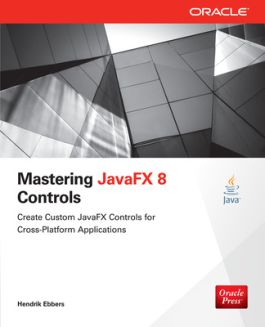Mastering JavaFX 8 Controls
1st Edition
0071833773
·
9780071833776
© 2014 | Published: June 16, 2014
Publisher's Note: Products purchased from Third Party sellers are not guaranteed by the publisher for quality, authenticity, or access to any online entitlements included with the product.Design and Deploy High-Performance JavaFX ControlsDeliver …
Read More
Purchase Options
Request Review Copy
Chapter 1. The History of Java UI Toolkits
Chapter 2. JavaFX Basics
Chapter 3. The Scene Graph
Chapter 4. Laying Out and Transforming Nodes in the Scene Graph
Chapter 5. JavaFX Basic Controls
Chapter 6. Additional JavaFX Controls
Chapter 7. Additional JavaFX Nodes
Chapter 8. Integrating JavaFX, Swing and SWT
Chapter 9. Styling a Control
Chapter 10. Custom Controls
Appendix A. JavaFX Resources and Where to Go from Here
Chapter 2. JavaFX Basics
Chapter 3. The Scene Graph
Chapter 4. Laying Out and Transforming Nodes in the Scene Graph
Chapter 5. JavaFX Basic Controls
Chapter 6. Additional JavaFX Controls
Chapter 7. Additional JavaFX Nodes
Chapter 8. Integrating JavaFX, Swing and SWT
Chapter 9. Styling a Control
Chapter 10. Custom Controls
Appendix A. JavaFX Resources and Where to Go from Here
Publisher's Note: Products purchased from Third Party sellers are not guaranteed by the publisher for quality, authenticity, or access to any online entitlements included with the product.
Design and Deploy High-Performance JavaFX Controls
Deliver state-of-the-art applications with visually stunning UIs. Mastering JavaFX 8 Controls provides clear instructions, detailed examples, and ready-to-use code samples. Find out how to work with the latest JavaFX APIs, configure UI components, automatically generate FXML, build cutting-edge controls, and effectively apply CSS styling. Troubleshooting, tuning, and deployment are also covered in this Oracle Press guide.
- Understand the properties of JavaFX 8 controls and APIs
- Create custom controls, transformations, and layouts
- Work from JavaFX Scene Graph and Scene Builder
- Visualize data models using advanced control types
- Use ListView, TableView, and TreeView APIs
- Handle audio and video content using JavaFX media classes
- Maximize separation between UI and application logic using FXML
- Style controls and applications using CSS
- Extend functionality of Swing and SWT applications with JavaFX
Code examples in the book are available for download.

